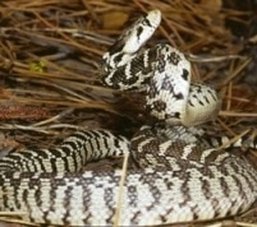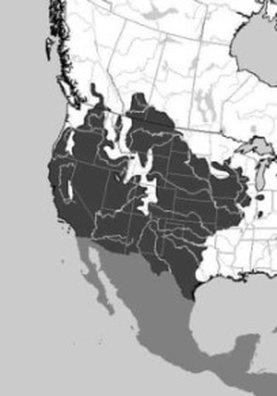Gopher SnakePituophis catenifer |

Custom Search
|
The gopher snake is found from southern Canada, as far south as southern Sinaloa and Veracruz in Mexico.
Due to their wide distribution, the gopher snake is found in a wide variety of habitats, including deserts, woodlands, coniferous forests, cultivated fields, prairies, grassland and forest edges, chaparral and shrublands. The species is found from sea level to over 2700 meters (9000 ft) in altitude. The species and its several sub-species are known by several common names like pine snake, bull snake, Henry snake, Pacific gopher snake, coast gopher snake, Pacific pine snake, bull snake, Sonoran gopher snake, Churchill's bull snake, Oregon bull snake, western bull snake, western gopher snake, western pine snake and yellow gopher snake. There are several subspecies currently recognized but their classification needs more studies and clarification (see Subspecies / Taxonomy below). Gopher snakes will puff up their body and curl themselves into the classic "S" strike pose of a pit viper as a defensive mechanism. They will also rapidly shake their tails, mimicking rattlesnakes like the Mojave rattlesnake. They do such a good job that many are killed by humans as if they were rattlesnakes. Gopher snakes are known for striking with a closed mouth, using its blunt nose to "warn off" possible predators. These are large non-venomous snakes, but even so, they can inflict a very painful bite if harassed or handled.

Although a captive gopher snake lived over 33 years their life expectancy in the wild is typically 12 to 15 years. Adult gopher snakes reach a length anywhere from 36 to 108 inches (91 to 275 cm).
The upper body is gray, pale brown to yellowish, with a series of large black or dark brown blotches, and smaller dark spots on the sides. The belly is usually a uniform white to yellowish color, but sometimes it can have brown markings. They have a relatively large head with large eyes and narrow neck, keeled scales in the upper body and a single anal scale. The species color patterns will vary regionally to mimic the colors of their environment. The most common gopher snake predators include red-tailed hawks, foxes and coyotes and large king snakes. These are solitary snakes, living alone in dens or other adequate shelters all year, except during the mating season. Subspecies / Taxonomy
Just like with many other snake species currently, scientists don't agree on a uniform classification for the species. There are up to 11 subspecies recognized, with several subspecies proposed representing the isolated island populations, and some have been proposed to attain a full species status. These are the most commonly accepted subspecies currently recognized. Bullsnake (Pituophis catenifer sayi) - Found throughout central and western North America, including the US Canada's British Columbia and northern Mexico. Click here to find out more about the bullsnake. Sonoran gopher snake (Pituophis catenifer affinis) - Found across the Southwestern US from west Texas to southeastern California extending south into the northern Mexico, especially in the Sonoran Desert. San Diego gopher snake (Pituophis catenifer annectens) - Found in the southwest regions of the USA and in the north of Mexico. Pacific gopher snake (Pituophis catenifer catenifer) - Found in the US, west of the Cascade Range in Oregon, south into California, west of the Sierra Nevada to northern Santa Barbara County and the Tehachapi Mountains. Great Basin gopher snake (Pituophis catenifer deserticola) - Found in South Canada and the western United States. Santa Cruz gopher snake (Pituophis catenifer pumilis) - Found only in the 96 square miles (248 km2) Santa Cruz Island, located just 25 miles off the coast of Santa Barbara, California. This was once the largest privately owned island in the USA. Cape gopher snake (Pituophis catenifer vertebralis) - Found in southernmost Baja California. Cedros Island gopher snake (Pituophis catenifer insulanus) - Found only on the Credos island (Isla de Credos) off the Pacific coast of the Mexican peninsular Baja California. San Martin Island gopher snake (Pituophis catenifer fuliginatus) - Found on the little volcanic San Martin island (Isla San Martin) in the San Quintin Bay just 4 km in front of the northern Pacific coast of the Mexican peninsula Baja California. Central Baja California gopher snake (Pituophis catenifer bimaris) - These snakes live in the west of Mexico on the peninsular Baja California. Coronado Island gopher snake (Pituophis catenifer coronalis) - Found only on a small group of Mexican Islands known as the “Islas De Los Coronados” which translates to Crown Islands or Crowned Islands in English. In the US these islands located about 26 miles off the west coast of the San Diego are called Coronado Islands. Diet / Feeding The gopher snake is a constrictor, and their diet consists mostly of mammals like mice, moles, gophers, chipmunks, squirrels and small rabbits. Sometimes insects, bats, lizards, birds, birds eggs, small snakes and even rattlesnakes are also eaten. In some parts of their range, these snakes feed mostly on gophers hence their common name "gopher snake". The gopher snake actively searches for prey in their burrows and hiding places and sometimes they will take possession of a burrow after killing and eating its inhabitants. Once the gopher snake kills its prey, it swallows it whole, and sometimes takes up to a week to digest it. Reproduction The gopher snake mating season occurs in July and August when females emit chemicals through their skin to attract males and stimulating the mating behavior. This is the only time of year these snakes socialize, year round they are solitary animals. The males engage in ritualistic combats during the mating season, where they remain on the ground, with their bodies intertwined from head to tail. The gopher snake is oviparous, meaning it lays eggs, sometimes females lay anywhere from 2 to 24 eggs, and sometimes will even lay 2 clutches in one season. The white or cream colored eggs are incubated in nests for a period of 65 to 75 days. The eggs are laid in small mammal burrows, beneath logs or large or in burrows excavated by the female. The nests are sometimes communal and used by other female gopher snakes. Once younglings hatch from the eggs, they are independent and left to fend for themselves. The hatchlings are born 12 to 18 inches (30 to 45 cm) long and after just 1 year may reach 3 ft (92 cm) long, and in the first 3 years, growth is rapid. While male gopher snakes reach sexual maturity between 1 and 2 years of age, females take longer and only reach sexual maturity between 3 and 5 years of age. Conservation / Threats The gopher snake population numbers are fairly stable throughout its massive range. The species is listed as a species of "Least Concern" on the IUCN list. Population declines have occurred in some areas where extensive, intensive agricultural or urban development has occurred. But gopher snakes have adapted to live in these rural residential areas and semi-agricultural landscapes. Also, some of the gopher snakes island populations are far more vulnerable to human persecution or environmental changes.
|
Did You Know?
Found in South America the green anaconda is, considered the largest snake in the world. Scientific Classification |
© 2014 Snake Facts About Us | Privacy Policy | Contact




